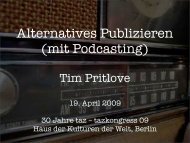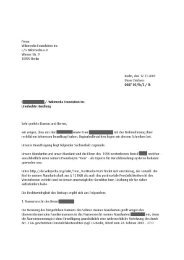Proceedings
Proceedings
Proceedings
Create successful ePaper yourself
Turn your PDF publications into a flip-book with our unique Google optimized e-Paper software.
| 272<br />
cooperation. Getting the new “playmates” to adopt<br />
the vision, culture and spirit of the original idea and<br />
holding true to it during the work on the proposal<br />
and negotiation process was a challenge indeed.<br />
The formal project organization required by the<br />
EU imposed more structure on the previous more<br />
free-floating agile process. Roles and responsibilities<br />
where staked out, conforming with the requirements<br />
of the roles but delegating as much as possible<br />
of the responsibilities and decision-making to the<br />
core developers. The strategy was to keep “conceptual<br />
integrity” (Brooks) of the vision and the idea in<br />
the hands of the core developers. A somewhat negative<br />
result was the added workload and responsibility<br />
on developers regarding EU related work. It is not<br />
too surprising that the consortium with its member<br />
organisation now employs a version-control/review<br />
based scheme regarding EU documents reflecting the<br />
technical development approaches.<br />
It remains a challenge for all partners of the consortium,<br />
universities and companies alike, to connect an<br />
ongoing medium-scale open-source project with EU<br />
regulations and requirements - not to speak of the fact<br />
that companies need to fund 50% of the costs themselves.<br />
It is, in fact, too early to judge the overall<br />
success of our approaches although we are confident<br />
that things work out reasonably well.<br />
2.3 challenges: balancing community<br />
interests with EU requirements<br />
The nature of sprints changed when EU funding<br />
started. The need to meet milestones of promised<br />
deliverables and the goal to keep an open sprint process,<br />
still welcoming newcomers into the world of<br />
Pypy, made the sprints longer (at least 7 days with a<br />
break day in the middle) but also changed the nature<br />
of the sprints. The team started to distuingish between<br />
sprints open for all to attend, without any prior<br />
PyPy experience, and sprints requiring earlier PyPy<br />
involvement. Tutorials, start up planning meetings<br />
as well as daily status meetings evolved, the latest<br />
additions to the sprints are closing planning meetings<br />
(planning the work between sprints) and work-groups<br />
- a version of pair-programming in groups.<br />
Some other effects of sprinting within the EUstructure<br />
is that the sprint becomes a forum for nondevelopment<br />
work - coordinating and tracking the<br />
project. The challenge here is not affecting the main<br />
work and “disturbing” visiting developers with EUrelated<br />
work. It could also be argued that the prolonged<br />
sprints could possibly make it more difficult<br />
for non consortium members to attend the full time,<br />
disturbing other engagements etc.<br />
The project continues to try to adapt the method<br />
5<br />
of sprinting, evaluating feedback from sprint participants.<br />
Maybe the implementation within the PyPy<br />
team is slowly conforming to the Scrum standard of<br />
sprinting, but not as a conscious effort?<br />
2.4 Managing diversities: agile business<br />
For a diverse group of organisations and people,<br />
agility is helpful at various levels: you cannot make<br />
all-encompassing plans and hope to statically follow<br />
them and succeed. New developments, twists and opportunities<br />
evolve all the time.<br />
Our experience with evolving PyPy from a loose<br />
Open Source project to a partially funded EU research<br />
project shows the following:<br />
• what first seemed like too diverse interests and<br />
views, impossible to tailor into a single project,<br />
was instead a fruitful mix of diversities. The challenge<br />
is to manage these diversities and channel<br />
them into constructive team efforts. Aiming for<br />
homogenity is the real threat.<br />
• what first seemed like unbeatable odds and too<br />
big obstacles sometimes even turned into new<br />
possibilities. The challenge is to maintain an<br />
atmosphere in which a team can act on those<br />
and within short timeframes of opportunities.<br />
Change is inevitable - how you handle it is the<br />
real challenge.<br />
• there are many other projects and organisations<br />
who are heading in similar directions of trying to<br />
connect and evolve agile open source strategies<br />
with business matters. Emerging models for developers<br />
distributed between different countries<br />
allows people with special interests to effectively<br />
work together and learn from each other.<br />
Concluding - the cumulative effects of an agile,<br />
open and dynamic team process combined with a<br />
market and curious first adopters facilitates agile business.<br />
A positive result is that a lot of people within<br />
the PyPy context found enjoyable jobs and there now<br />
already is evolving commercial interest despite the<br />
still early stages of the project - mostly from US<br />
companies though ... why european companies, especially<br />
larger ones, appear to prefer taking rather naive<br />
views on agile open-source development (“great, it’s<br />
cheaper, no license fees!”) is another interesting topic.






